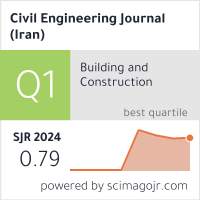The Impact of Aspect Ratio, Characteristic Strength and Compression Rebars on the Shear Capacity of Shallow RC Beams
Downloads
Doi:10.28991/CEJ-2023-09-09-012
Full Text:PDF
Downloads
[2] Serna-Ros, P., Fernandez-Prada, M. A., Miguel-Sosa, P., & Debb, O. A. R. (2002). Influence of stirrup distribution and support width on the shear strength of reinforced concrete wide beams. Magazine of Concrete Research, 54(3), 181–191. doi:10.1680/macr.2002.54.3.181.
[3] ACI 318-19. (2019). Building Code Requirements for Structural Concrete (ACI 318-19) Commentary on Building Code Requirements for Structural Concrete (ACI 318R-19). American Concrete Institute (ACI), Michigan, United States.
[4] Lubell, A., Sherwood, T., Bentz, E., & Collins, M. (2004). Safe shear design of large wide beams. Concrete International, 26(1), 66-78.
[5] Özbek, E., Aykaç, B., Bocek, M., Yılmaz, M. C., Mohammed, A. B. K., Er, Šž. B., & Aykaç, S. (2020). Behavior and strength of hidden RC beams embedded in slabs. Journal of Building Engineering, 29. doi:10.1016/j.jobe.2019.101130.
[6] Alluqmani, A. E. (2020). Effect of the transversal-spacing of stirrup-legs on the behavior and strength of shallow concealed RC beams. Journal of Engineering, Design and Technology, 19(4), 932–942. doi:10.1108/JEDT-06-2020-0224.
[7] Taha, M. G., & Abbas, A. L. (2021). Effect of Longitudinal Maximum Spacing of Shear Reinforcement for wide Reinforced Concrete Beams. IOP Conference Series: Materials Science and Engineering, 1076(1), 012118. doi:10.1088/1757-899x/1076/1/012118.
[8] Mahmoud, S. M., Mabrouk, R. T. S., & Kassem, M. E. (2021). Behavior of RC Wide Beams under Eccentric Loading. Civil Engineering Journal, 7(11), 1880–1897. doi:10.28991/cej-2021-03091766.
[9] Elansary, A. A., Elnazlawy, Y. Y., & Abdalla, H. A. (2022). Shear behaviour of concrete wide beams with spiral lateral reinforcement. Australian Journal of Civil Engineering, 20(1), 174–194. doi:10.1080/14488353.2021.1942405.
[10] Moubarak, A. M. R., Elwardany, H., Abu El-hassan, K., & El-Din Taher, S. (2022). Shear strengthening of wide-shallow beams by inserted fasteners. Engineering Structures, 268. doi:10.1016/j.engstruct.2022.114554.
[11] Yousef, A. M., Marami, N. A., & Tahwia, A. M. (2023). Experimental and Numerical Investigation for Torsional Behavior of UHPFRC Shallow and Deep Beams. Arabian Journal for Science and Engineering, 1–14. doi:10.1007/s13369-023-07701-3.
[12] Koo, S., Shin, D., & Kim, C. (2021). Application of principal component analysis approach to predict shear strength of reinforced concrete beams with stirrups. Materials, 14(13), 3471. doi:10.3390/ma14133471.
[13] Fan, X., Wang, S., & Zhang, Z. (2020). A Study of Size Effect in Shear Resistance of Reinforced Concrete Beams Based on Machine Learning. IOP Conference Series: Earth and Environmental Science, 455(1), 12099. doi:10.1088/1755-1315/455/1/012099.
[14] De Domenico, D., Quaranta, G., Zeng, Q., & Monti, G. (2022). Machine-learning-enhanced variable-angle truss model to predict the shear capacity of RC elements with transverse reinforcement. Procedia Structural Integrity, 44, 1688–1695. doi:10.1016/j.prostr.2023.01.216.
[15] Wang, S., Ma, C., Wang, W., Hou, X., Xiao, X., Zhang, Z., Liu, X., & Liao, J. J. (2023). Prediction of Failure Modes and Minimum Characteristic Value of Transverse Reinforcement of RC Beams Based on Interpretable Machine Learning. Buildings, 13(2), 469. doi:10.3390/buildings13020469.
[16] Soliman, A. A., Mansour, D. M., Ebid, A., & Khalil, A. H. (2023). Shallow and Wide RC Beams, Definition, Capacity and Structural Behavior – Gap Study. The Open Civil Engineering Journal, 17(1), 1-11. doi:10.2174/18741495-v17-e230725-2023-28.
[17] BS 8110-1:1997. (1997). Structural use of concrete. Code of practice for design and construction (AMD 9882- 13468). British Standards Institution (BSI), London, United Kingdom.
[18] EN 1992-1-1. (2004). Eurocode 2: Design of concrete structures - Part 1-1: General rules and rules for buildings. European Committee for Standardization (CEN), Brussels, Belgium.
[19] IS 456. (2000). Plain and Reinforced Concrete-Code of Practice (Fourth Revision). Bureau of Indian Standards, New Delhi, India.
[20] JSCE Guidelines for Concrete No. 16. (2007). Standard Specifications for Concrete Structures. Japan Society of Civil Engineers, Tokyo, Japan.
[21] Ramadan, M., Ors, D. M., Farghal, A. M., Afifi, A., Zaher, A. H., & Ebid, A. M. (2023). Punching shear behavior of HSC & UHPC post tensioned flat slabs – An experimental study. Results in Engineering, 17, 100882. doi:10.1016/j.rineng.2023.100882.
[22] Ebid, A. M., & Deifalla, A. (2021). Prediction of shear strength of FRP reinforced beams with and without stirrups using (GP) technique. Ain Shams Engineering Journal, 12(3), 2493–2510. doi:10.1016/j.asej.2021.02.006.
[23] Ebid, A. M., Deifalla, A. F., & Mahdi, H. A. (2022). Evaluating Shear Strength of Light-Weight and Normal-Weight Concretes through Artificial Intelligence. Sustainability (Switzerland), 14(21), 14010. doi:10.3390/su142114010.
- Authors retain all copyrights. It is noticeable that authors will not be forced to sign any copyright transfer agreements.
- This work (including HTML and PDF Files) is licensed under a Creative Commons Attribution 4.0 International License.![]()















